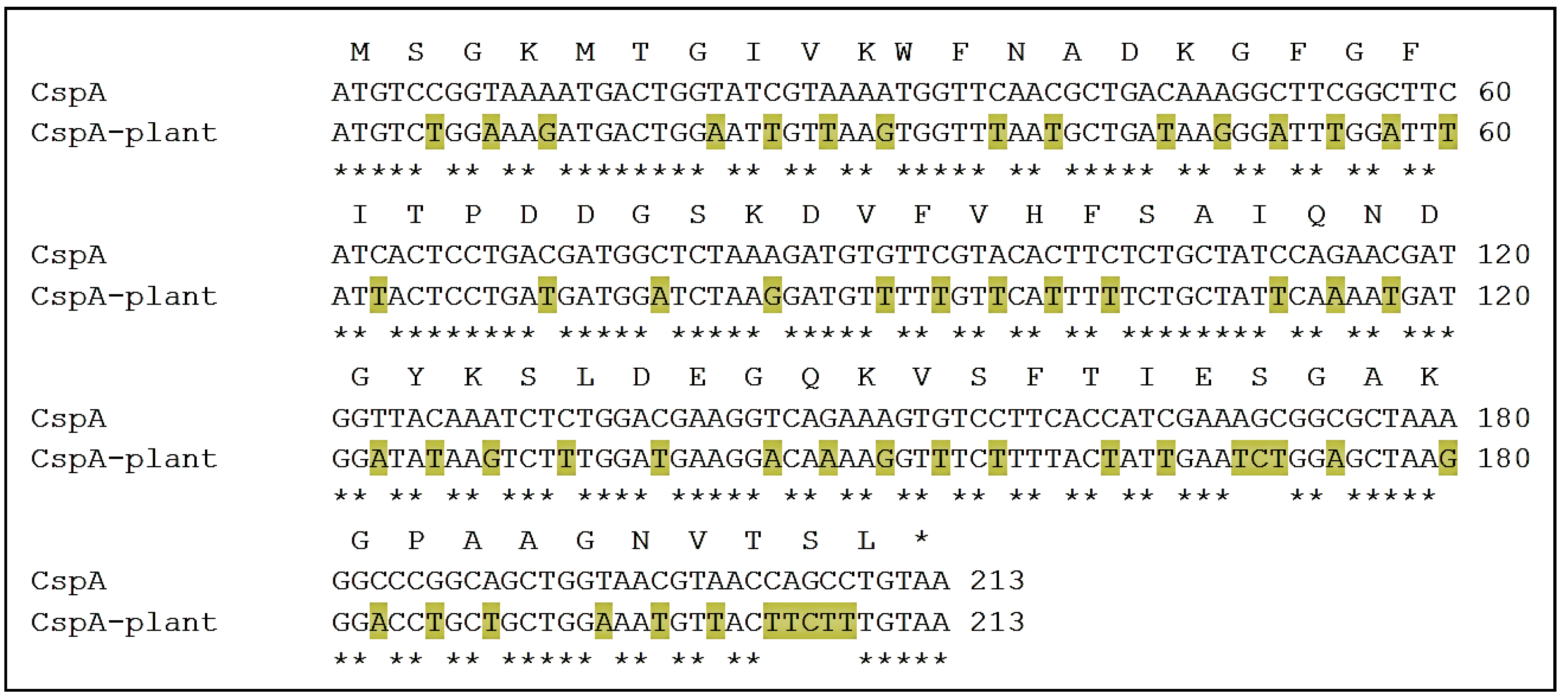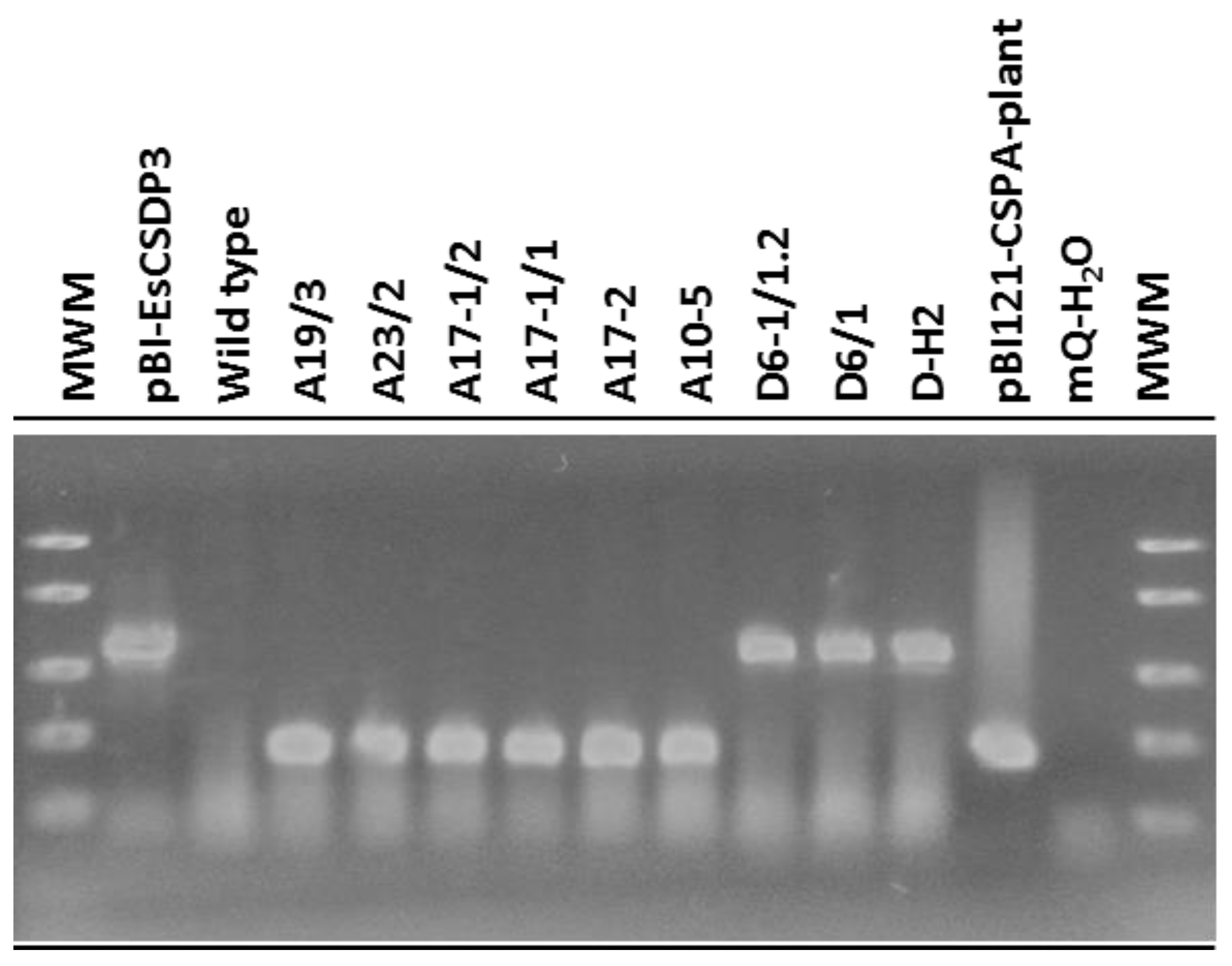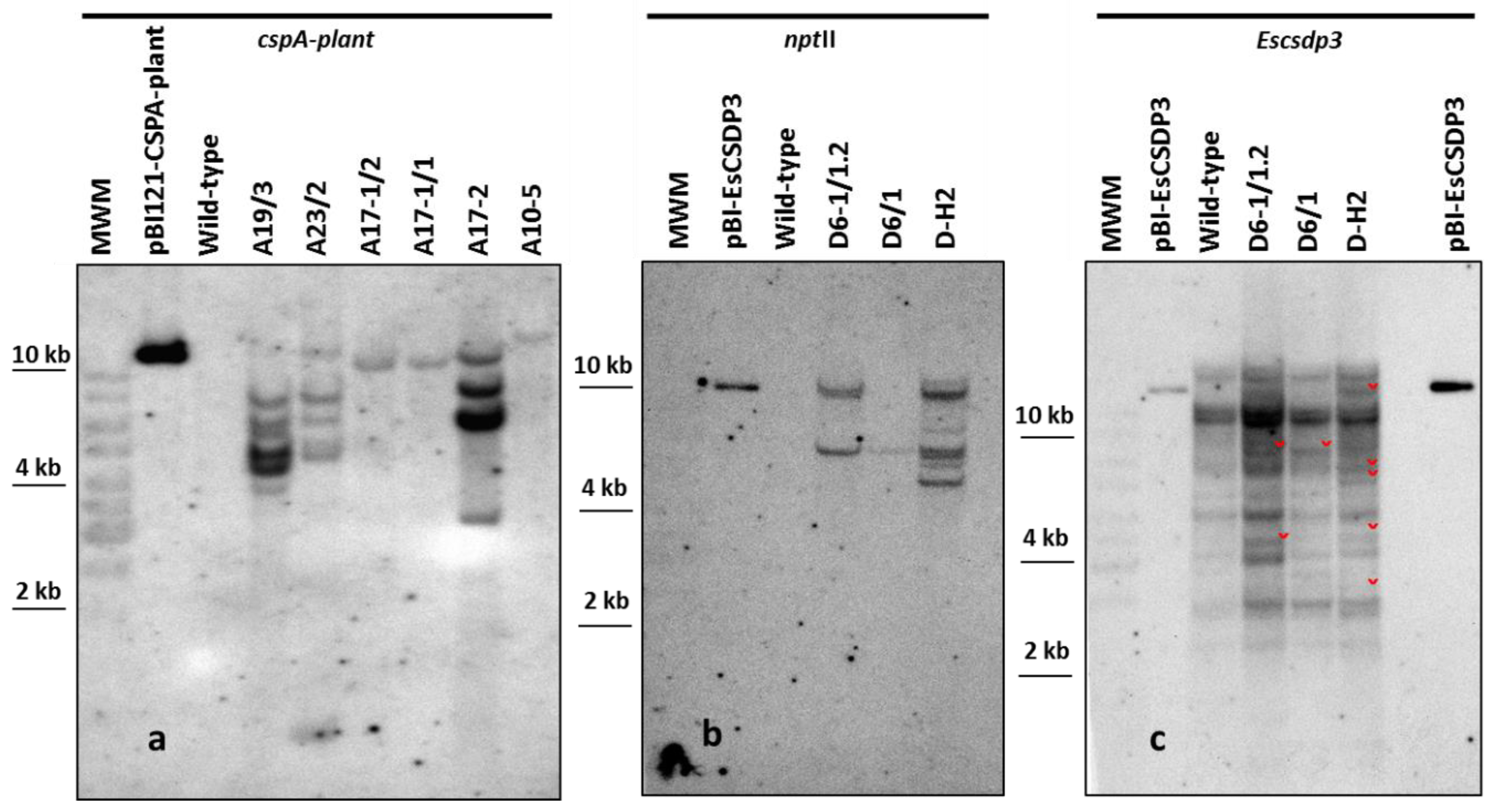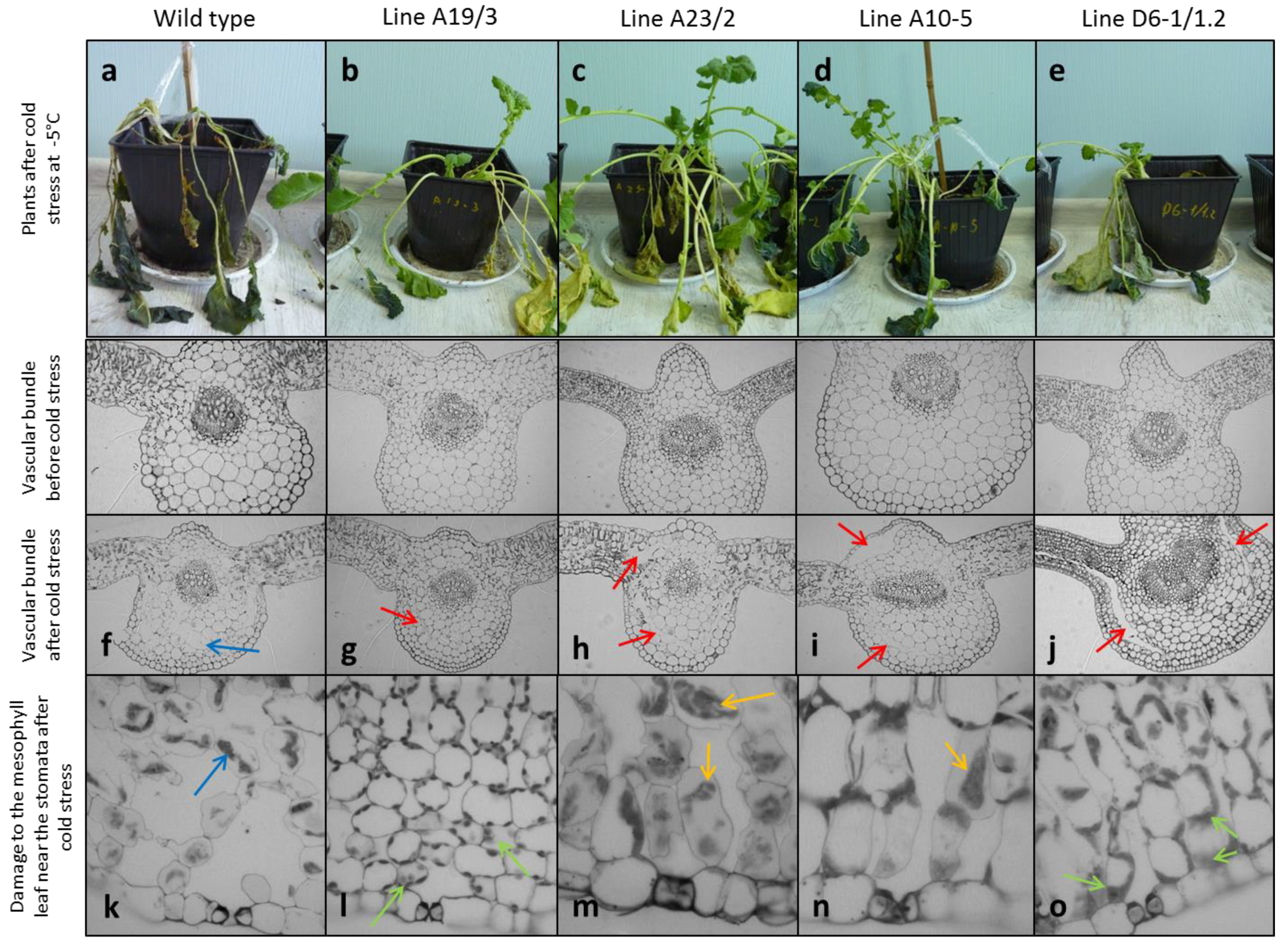Genes with Cold Shock Domain from Eutrema salsugineum (Pall.) for Generating a Cold Stress Tolerance in Winter Rape (Brassica napus L.) Plants †
Abstract
1. Introduction
2. Materials and Methods
2.1. Gene Synthesis and Plasmid Construction
2.2. Optimization of the Codon Usage of the cspA Gene
2.3. Mutant Bacteria Growth Complementation
2.4. Creation of Genetic Constructs for Overexpression
2.5. Tissue Culture, Agrobacterium-Mediated Transformation, and Obtaining Generation T0
2.6. Adaptation, Growing Plants In Vivo, and Obtaining Generation T1
2.7. Analysis of Transformants
2.7.1. Polymerase Chain Reaction (PCR)
2.7.2. Semiquantitative RT-PCR (Reverse Transcriptase PCR) and Quantitative RT-PCR Analyzes of Transgenic Rapeseed (Real-Time qPCR)
2.8. Southern Blot Analysis
2.9. Study of Plant Resistance to Cold and Frost
Plant Selection
2.10. Potentiometric Analysis of Electrolyte Leakage from Plant Tissue
2.11. Light Microscopy and Tissue Preparation
2.12. Analysis of Moisture Retention in Plants
3. Results
3.1. Synthetic Gene and Plasmid Construction
3.2. Agrobacterium-Mediated Transformation
3.3. Analysis of Transformants
3.4. Study of Plant Resistance to Cold and Frost
4. Discussion
Author Contributions
Funding
Institutional Review Board Statement
Informed Consent Statement
Acknowledgments
Conflicts of Interest
References
- Rihan, H.Z.; Al-Issawi, M.; Fuller, M.P. Advances in physiological and molecular aspects of plant cold tolerance. J. Plant Interact. 2017, 12, 143157. [Google Scholar] [CrossRef]
- Leisner, C.P. Climate change impacts on food security- focus on perennial cropping systems and nutritional value. Plant Sci. 2020, 293, 1104122. [Google Scholar] [CrossRef]
- Guo, X.Y.; Liu, D.F.; Chong, K. Cold signaling in plants: Insights into mechanisms and regulation. J. Integr. Plant Biol. 2018, 60, 745–756. [Google Scholar] [CrossRef]
- Liu, J.; Shi, Y.; Yang, S. Insights into the regulation of CBF cold signaling in plants. J. Integr. Plant Biol. 2018, 9, 780–795. [Google Scholar] [CrossRef] [PubMed]
- Yanglin, D.; Yiting, S.; Shuhua, Y. Advances and challenges in uncovering cold tolerance regulatory mechanisms in plants. New Phytol. 2019, 222, 1690–1704. [Google Scholar]
- Hannah, M.A.; Heyer, A.G.; Hincha, D.K. A global survey of gene regulation during cold acclimation in Arabidopsis thaliana. PLoS Genet. 2005, 1, e26. [Google Scholar] [CrossRef]
- Heidarvand, L.; Maali Amiri, R. What happens in plant molecular responses to cold stress? Acta Physiol. Plant 2010, 32, 419–431. [Google Scholar] [CrossRef]
- Shi, Y.; Ding, Y.; Yang, S. Molecular regulation of CBF signaling in cold acclimation. Trends Plant Sci. 2018, 23, 623–637. [Google Scholar] [CrossRef]
- Jaglo, K.R.; Kleff, S.; Amundsen, K.L.; Zhang, X.; Haake, V.; Zhang, J.Z.; Deits, T.; Thomashow, M.F. Components of the Arabidopsis C-repeat/dehydrationresponsive element binding factor cold-response pathway are conserved in Brassica napus and other plant species. Plant Physiol. 2001, 127, 910–917. [Google Scholar]
- Choi, D.-W.; Rodriguez, E.M.; Close, T.J. Barley Cbf3 gene identification, expression pattern, and map location. Plant Physiol. 2002, 129, 1781–1787. [Google Scholar] [CrossRef]
- Gao, M.-J.; Allard, G.; Byass, L.; Flanagan, A.M.; Singh, J. Regulation and characterization of four CBF transcription factors from Brassica napus. Plant Mol. Biol. 2002, 49, 459–471. [Google Scholar] [CrossRef] [PubMed]
- Owens, C.L.; Thomashow, M.F.; Hancock, J.F.; Iezzoni, A.F. CBF1 orthologs in sour cherry and strawberry and the heterologous expression of CBF1 in strawberry. J. Am. Soc. Hortic. Sci. 2002, 127, 489–494. [Google Scholar] [CrossRef]
- Dubouzet, J.G.; Sakuma, Y.; Ito, Y.; Kasuga, M.; Dubouzet, E.G.; Miura, S.; Seki, M.; Shinozaki, K.; Yamaguchi-Shinozaki, K. OsDREB genes in rice, Oryza sativa L., encode transcription activators that function in drought-, high-salt- and cold-responsive gene expression. Plant J. 2003, 33, 751–763. [Google Scholar] [CrossRef] [PubMed]
- Vágújfalvi, A.; Galiba, G.; Cattivelli, L.; Dubcovsky, J. The cold regulated transcriptional activator Cbf3 is linked to the frost-tolerance locus Fr-A2 on wheat chromosome 5A. Mol. Genet. Genom. 2003, 269, 60–67. [Google Scholar] [CrossRef]
- Xue, G.-P. The DNA-binding activity of an AP2 transcriptional activator HvCBF2 involved in regulation of low-temperature responsive genes in barley is modulated by temperature. Plant J. 2003, 33, 373–383. [Google Scholar] [CrossRef]
- Francia, E.; Rizza, F.; Cattivelli, L.; Stanca, A.M.; Galiba, G.; Toth, B.; Hayes, P.M.; Skinner, J.S.; Pecchioni, N. Two loci on chromosome 5H determine low-temperature tolerance in a ’Nure’ (winter) × ’Tremois’ (spring) barley map. Theor. Appl. Genet. 2004, 108, 670–680. [Google Scholar] [CrossRef]
- Sanghera, G.S.; Wani, S.H.; Hussain, W.; Singh, N.B. Engineering cold stress tolerance in crop plants. Curr. Genom. 2011, 12, 30. [Google Scholar] [CrossRef]
- Mizoi, J.; Shinozaki, K.; Yamaguchi-Shinozaki, K. AP2/ERF family transcription factors in plant abiotic stress responses. Biochim. Biophys. Acta 2012, 1819, 86–96. [Google Scholar] [CrossRef]
- Wisniewski, M.; Nassuth, A.; Teulieres, C.; Marque, C.; Rowland, J.; Cao, P.B.; Brown, A. Genomics of cold hardiness in woody plants. Crit. Rev. Plant Sci. 2014, 33, 92–124. [Google Scholar] [CrossRef]
- Gilmour, S.J.; Fowler, S.J.; Thomashow, M.F. Arabidopsis transcriptional activators CBF1, CBF2, and CBF3 have matching functional activities. Plant Mol. Biol. 2004, 54, 767–781. [Google Scholar] [CrossRef] [PubMed]
- Vazquez-Hernandez, M.; Romero, I.; Escribano, M.I.; Merodio, C.; Sanchez-Ballesta, M.T. Deciphering the role of CBF/DREB transcription factors and dehydrins in maintaining the quality of table grapes cv. autumn royal treated with high CO2 levels and stored at 0 °C. Front. Plant Sci. 2017, 8, 1591. [Google Scholar] [CrossRef] [PubMed]
- Umezawa, T.; Fujita, M.; Fujita, Y.; Yamaguchi-Shinozaki, K.; Shinozaki, K. Engineering drought tolerance in plants: Discovering and tailoring genes to unlock the future. Curr. Opin. Biotechnol. 2006, 17, 113–122. [Google Scholar] [CrossRef] [PubMed]
- Xin, Z.; Mandaokar, A.; Chen, J.; Last, R.L.; Browse, J. Arabidopsis ESK1 encodes a novel regulator of freezing tolerance. Plant J. 2007, 49, 786–799. [Google Scholar] [CrossRef] [PubMed]
- Skabkin, M.A.; Skabkina, O.V.; Ovchinnikov, L.P. Multifunctional proteins with a cold shock domain in the regulation of gene expression. Adv. Biol. Chem. 2004, 44, 3–52. (In Russian) [Google Scholar]
- Xia, B.; Ke, H.P.; Inouye, M. Acquirement of cold sensitivity by quadruple deletion of the cspA family and its suppression by PNPase S1 domain in Escherichia coli. Mol. Microbiol. 2001, 40, 179–188. [Google Scholar] [CrossRef]
- Nakaminami, K.; Sasaki, K.; Kajita, S.; Takeda, H.; Karlson, D.; Ohgi, K.; Imai, R. Heat stable ssDNA/RNA-binding activity of a wheat cold shock domain protein. FEBS Lett. 2005, 579, 4887–4891. [Google Scholar] [CrossRef]
- Sasaki, K.; Imai, R. Pleiotropic roles of cold shock domain proteins in plants. Front. Plant Sci. 2012, 2, 116. [Google Scholar] [CrossRef]
- Rajasheker, G.; Kumar, A.S.; Kumari, H.P.; Kishor, K.P.B. Bacterial cold shock proteins-themolecular chaperones for multiple stress tolerance. Adv. Biotech. Micro. 2019, 12, 555837. [Google Scholar]
- Sasaki, K.; Kim, M.H.; Imai, R. Arabidopsis cold shock domain protein 2 is a RNA chaperone that is regulated by cold and developmental signals. Biochem. Biophys. Res. Commun. 2007, 364, 633–638. [Google Scholar] [CrossRef]
- Jung, Y.H.; Yi, J.Y.; Jung, H.J.; Lee, Y.K.; Lee, H.K.; Naicker, M.C.; Uh, J.H.; Jo, I.S.; Jung, E.J.; Im, H. Overexpression of cold shock protein A of Psychromonas arctica KOPRI 22215 confers cold-resistance. Protein J. 2010, 29, 136–142. [Google Scholar] [CrossRef]
- Karlson, D.; Imai, R. Conservation of the cold shock protein of Escherichia coli. Plant Physiol. 2003, 131, 12–15. [Google Scholar] [CrossRef]
- Nakaminami, K.; Karlson, D.T.; Imai, R. Functional conservation of cold shock domains in bacteria and higher plants. Proc. Natl. Acad. Sci. USA 2006, 103, 10122–10127. [Google Scholar] [CrossRef]
- Castiglioni, P.; Warner, D.; Bensen, R.J.; Anstrom, D.C.; Harrison, J.; Stoecker, M.; Abad, M.; Kumar, G.; Salvador, S.; D’ordine, R.; et al. Bacterial RNA chaperones confer abiotic stress tolerance in plants and improved grain yield in maize under water-limited conditions. Plant Physiol. 2008, 147, 446–455. [Google Scholar] [CrossRef] [PubMed]
- Kim, J.C.; Lee, S.H.; Cheong, Y.H.; Yoo, C.M.; Lee, S.I.; Chun, H.J.; Yun, D.J.; Hong, J.C.; Lee, S.Y.; Lim, C.O.; et al. A novel cold-inducible zinc finger protein from soybean, SCOF-1, enhances cold tolerance in transgenic plants. Plant J. 2001, 25, 247–259. [Google Scholar] [CrossRef]
- Vannini, C.; Locatelli, F.; Bracale, M.; Magnani, E.; Marsoni, M.; Osnato, M.; Mattana, M.; Baldoni, E.; Coraggio, I. Overexpression of the rice Osmyb4 gene increases chilling and freezing tolerance of Arabidopsis thaliana plants. Plant J. 2004, 37, 115–127. [Google Scholar] [CrossRef]
- Zhu, B.; Xiong, A.-S.; Peng, R.-H.; Xu, J.; Jin, X.-F.; Meng, X.-R.; Yao, Q.-H. Over-expression of ThpI from Choristoneura fumiferana enhances tolerance to cold in Arabidopsis. Mol. Biol. Rep. 2010, 37, 961. [Google Scholar] [CrossRef] [PubMed]
- Deng, S.; Sun, J.; Zhao, R.; Ding, M.; Zhang, Y.; Sun, Y.; Wang, W.; Tan, Y.; Liu, D.; Ma, X.; et al. Populus euphratica APYRASE2 enhances cold tolerance by modulating vesicular trafficking and extracellular ATP in Arabidopsis plants. Plant Physiol. 2015, 169, 530–548. [Google Scholar] [CrossRef] [PubMed]
- Taranov, V.V.; Berdnikova, M.V.; Babakov, A.V.; Nosov, A.V.; Galkin, A.V. Cold shock domain proteins in the extremophyte Thellungiella salsuginea (salt cress): Gene structure and differential response to cold. Mol. Biol. 2010, 44, 889–897. [Google Scholar] [CrossRef]
- Taranov, V.V.; Zlobin, N.E.; Evlakov, K.I.; Shamustakimova, A.O.; Babakov, A.V. Contribution of Eutrema salsugineum cold shock domain structure to the interaction with RNA. Biochemistry 2018, 83, 1369–1379. [Google Scholar] [CrossRef]
- Zlobin, N.; Evlakov, K.; Alekseev, Y.; Blagodatskikh, K.; Babakov, A.; Taranov, V. High DNA melting activity of extremophyte Eutrema salsugineum cold shock domain proteins EsCSDP1and EsCSDP3. Biochem. Biophys. Rep. 2016, 5, 502–508. [Google Scholar] [PubMed]
- Zlobin, N.; Evlakov, K.; Tikhonova, O.; Babakov, A.; Taranov, V. RNA melting and RNA chaperone activities of plant cold shock domain proteins are not correlated. RNA Biol. 2018, 15, 1040–1046. [Google Scholar] [CrossRef] [PubMed]
- Grote, A.; Hiller, K.; Scheer, M.; Munch, R.; Nortemann, B.; Hempel, D.C.; Jahn, D. JCat: A novel tool to adapt codon usage of a target gene to its potential expression host. Nucleic Acids Res. 2005, 33, 526–531. [Google Scholar] [CrossRef]
- Xiong, A.S.; Yao, Q.H.; Peng, R.H.; Duan, H.; Li, X.; Fan, H.Q.; Cheng, Z.M.; Li, Y. PCR-based accurate synthesis of long DNA sequences. Nat. Protoc. 2006, 1, 791–797. [Google Scholar] [CrossRef]
- Lazo, G.R.; Stein, P.A.; Ludwig, R.A. A DNA transformation–competent Arabidopsis genomic library in Agrobacterium. Nat. Biotechnol. 1991, 9, 963–967. [Google Scholar] [CrossRef]
- Murashige, T.; Skoog, F. A revised medium for rapid growth and bio assays with tobacco tissue cultures. Physiol. Plant 1962, 15, 473–497. [Google Scholar] [CrossRef]
- Cardoza, V.; Stewart, C.N. Canola (Brassica napus L.). Agrobacterium Protoc. Methods Mol. Biol. 2006, 343, 257–266. [Google Scholar]
- Chernobrovkina, M.A.; Khvatkov, P.A.; Leonteva, A.V.; Dolgov, S.V. Study of the domestic breeding winter rape morphogenetic potential using in vitro culture. Int. J. Appl. Fundam. Res. 2017, 11, 260–264. [Google Scholar]
- Dellaporta, S.L.; Wood, J.; Hicks, J.B. A plant DNA minipreparation: Version II. Plant Mol. Biol. Rep. 1983, 1, 19–21. [Google Scholar] [CrossRef]
- Livak, K.; Schmittgen, T. Analysis of relative gene expression data using realtime quantitative PCR and the 211C(T). Methods 2001, 25, 402–408. [Google Scholar] [CrossRef]
- Rogers, S.O.; Bendich, A.J. Extraction of Total Cellular DNA from Plants, Algae and Fungi. In Plant Molecular Biology Manual; Gelvin, S.B., Schilperoort, R.A., Eds.; Springer: Dordrecht, The Netherlands, 1994; Volume 1, pp. 183–190. [Google Scholar]
- Dexter, S.T.; Tottindham, E.; Garber, L.G. Investigation of hardiness of plants by measurement of electrical conductivity. Plant Physiol. 1932, 7, 63–78. [Google Scholar] [CrossRef] [PubMed]
- Markowski, A.; Augustyniak, G.; Janowiak, F. Sensitivity of different species of field crops to chilling temperature. III. ATP content and electrolyte leakage from seedling leaves. Acta Physiol. Plant 1990, 12, 167–173. [Google Scholar]
- Rathore, D.S.; Doohan, F.; Mullins, E. Capability of the plant-associated bacterium, Ensifer adhaerens strain OV14, to genetically transform its original host Brassica napus. Plant Cell Tiss. Organ Cult. 2016, 127, 85–94. [Google Scholar] [CrossRef]
- Thomashow, M.F. Plant cold acclimation: Freezing tolerance genes and regulatory mechanisms. Annu. Rev. Plant Physiol. Mol. Biol. 1999, 50, 571–599. [Google Scholar] [CrossRef]
- Uemura, M.; Shigematsu, S.; Minami, A.; Kawamura, Y.; Nakagawara, C.H. Responses of the plasma membrane to low temperatures. Physiol. Plant. 2006, 126, 81–89. [Google Scholar] [CrossRef]
- Kumar, N.; Bhatt, R.P. Transgenics: An emerging approach for cold tolerance to enhance vegetables production in high altitude areas. Indian J. Crop Sci. 2006, 1, 8–12. [Google Scholar]
- Kim, M.H.; Sasaki, K.; Imai, R. Cold shock domain protein 3 regulates freezing tolerance in Arabidopsis thaliana. J. Biol. Chem. 2009, 284, 23454–23460. [Google Scholar] [CrossRef] [PubMed]
- Kasuga, M.; Miura, S.; Shinozaki, K.; Yamaguchi-Shinozaki, K. A combination of the Arabidopsis DREB1A gene and stress-inducible rd29A promoter improved drought- and low-temperature stress tolerance in tobacco by gene transfer. Plant Cell Physiol. 2004, 4, 346–350. [Google Scholar] [CrossRef] [PubMed]
- Bihmidine, S.; Lin, J.; Stone, J.M.; Awada, T.; Specht, J.E.; Clemente, T.E. Activity of the Arabidopsis RD29A and RD29B promoter elements in soybean under water stress. Planta 2013, 237, 55–64. [Google Scholar] [CrossRef]









| Name of Line | Loss of Electrolytes from Plant Tissues (%) | Saturation of Water Inside Plant Tissues (%) | ||||
|---|---|---|---|---|---|---|
| −3 °C at 24 h | −4 °C at 24 h | −5 °C at 24 h | −3 °C at 24 h | −4 °C at 24 h | −5 °C at 24 h | |
| Wild type | 16.1 ± 1.7 | 23.9 ± 2.1 | 71.4 ± 7.4 | 97.3 ± 2.1 | 95.2 ± 2.4 | 42.5 ± 2.7 |
| A19/3 | 10.7 ± 1.3 | 12.7 ± 0.8 | 19.0 ± 1.2 | 98.0 ± 2.3 | 96.0 ± 2.8 | 87.2 ± 2.4 |
| A23/2 | 12.9 ± 1.6 | 16.1 ± 1.1 | 34.8 ± 2.0 | 100.7 ± 1.8 | 97.6 ± 1.7 | 85.1 ± 2.5 |
| A17-1/1 | 21.6 ± 2.1 | 27.2 ± 2.9 | 63.7 ± 3.4 | 95.4 ± 2.4 | 57.9 ± 2.3 | 32.5 ± 3.3 |
| A17-1/2 | 14.6 ± 1.5 | 27.9 ± 2.3 | 68.2 ± 6.5 | 93.6 ± 2.2 | 80.3 ± 2.8 | 54.3 ± 2.1 |
| A17-2 | 14.2 ± 1.2 | 16.5 ± 0.7 | 58.3 ± 3.7 | 87.8 ± 3.1 | 81.8 ± 3.6 | 51.3 ± 3.8 |
| A10-5 | 12.7 ± 0.9 | 16.7 ± 0.8 | 36.9 ± 2.1 | 100.2 ± 1.9 | 98.9 ± 1.7 | 88.5 ± 2.4 |
| D6-1/1.2 | 11.0 ± 1.1 | 17.3 ± 1.0 | 38.9 ± 2.8 | 99.6 ± 2.2 | 93.9 ± 2.8 | 82.5 ± 2.7 |
| D6/1 | 12.3 ± 1.1 | 16.9 ± 1.5 | 55.8 ± 3.3 | 98.0 ± 2.6 | 94.8 ± 2.4 | 40.8 ± 3.1 |
| D-H2 | 13.0 ± 0.7 | 15.8 ± 1.2 | 57.1 ± 3.6 | 99.7 ± 2.3 | 96.7 ± 2.6 | 52.2 ± 3.6 |
| Name of Line | Loss of Electrolytes from Plant Tissues (%) | Saturation of Water Inside Plant Tissues (%) | ||||
|---|---|---|---|---|---|---|
| −8 °C at 24 h | −12 °C at 24 h | −16 °C at 24 h | −8 °C at 24 h | −12 °C at 24 h | −16 °C at 24 h | |
| Wild type | 11.9 ± 2.1 | 48.8 ± 4.3 | 62.7 ± 4.0 | 77.5 ± 3.2 | 56.6 ± 3.4 | 47.6 ± 3.8 |
| A19/3 | 14.0 ± 2.4 | 20.6 ± 2.3 | 34.7 ± 2.9 | 95.0 ± 4.6 | 67.6 ± 3.4 | 63.5 ± 3.6 |
| A23/2 | 8.0 ± 0.6 | 20.4 ± 2.1 | 48.1 ± 5.1 | 98.2 ± 2.2 | 69.8 ± 2.3 | 55.7 ± 2.6 |
| A17-1/1 | 44.4 ± 5.6 | 57.9 ± 5.8 | 70.5 ± 6.2 | 66.9 ± 4.1 | 45.9 ± 3.6 | 36.8 ± 3.4 |
| A17-1/2 | 11.3 ± 2.2 | 20.3 ± 2.0 | 53.3 ± 3.3 | 83.3 ± 3.3 | 56.2 ± 3.4 | 31.4 ± 2.8 |
| A17-2 | 12.9 ± 1.2 | 39.4 ± 2.3 | 61.3 ± 4.6 | 75.7 ± 2.9 | 58.4 ± 2.7 | 47.1 ± 2.4 |
| A10-5 | 10.2 ± 1.7 | 24.8 ± 2.2 | 47.2 ± 3.9 | 95.3 ± 4.6 | 71.9 ± 4.1 | 57.0 ± 3.8 |
| D6-1/1.2 | 7.3 ± 0.9 | 13.0 ± 1.4 | 28.2 ± 2.0 | 90.4 ± 3.5 | 78.6 ± 3.4 | 66.7 ± 2.7 |
| D6/1 | 6.2 ± 1.1 | 15.0 ± 1.5 | 38.4 ± 1.6 | 98.1 ± 2.4 | 59.6 ± 3.1 | 42.1 ± 3.6 |
| D-H2 | 10.4 ± 1.5 | 38.4 ± 4.3 | 49.8 ± 3.8 | 98.4 ± 1.8 | 66.8 ± 2.4 | 40.6 ± 1.9 |
Publisher’s Note: MDPI stays neutral with regard to jurisdictional claims in published maps and institutional affiliations. |
© 2021 by the authors. Licensee MDPI, Basel, Switzerland. This article is an open access article distributed under the terms and conditions of the Creative Commons Attribution (CC BY) license (https://creativecommons.org/licenses/by/4.0/).
Share and Cite
Khvatkov, P.; Taranov, V.; Pushin, A.; Maletich, G.; Fedorov, V.; Chaban, I.; Babakov, A.; Dolgov, S.; Chernobrovkina, M. Genes with Cold Shock Domain from Eutrema salsugineum (Pall.) for Generating a Cold Stress Tolerance in Winter Rape (Brassica napus L.) Plants. Agronomy 2021, 11, 827. https://doi.org/10.3390/agronomy11050827
Khvatkov P, Taranov V, Pushin A, Maletich G, Fedorov V, Chaban I, Babakov A, Dolgov S, Chernobrovkina M. Genes with Cold Shock Domain from Eutrema salsugineum (Pall.) for Generating a Cold Stress Tolerance in Winter Rape (Brassica napus L.) Plants. Agronomy. 2021; 11(5):827. https://doi.org/10.3390/agronomy11050827
Chicago/Turabian StyleKhvatkov, Pavel, Vasiliy Taranov, Alexander Pushin, Galina Maletich, Vladislav Fedorov, Inna Chaban, Alexsey Babakov, Sergey Dolgov, and Mariya Chernobrovkina. 2021. "Genes with Cold Shock Domain from Eutrema salsugineum (Pall.) for Generating a Cold Stress Tolerance in Winter Rape (Brassica napus L.) Plants" Agronomy 11, no. 5: 827. https://doi.org/10.3390/agronomy11050827
APA StyleKhvatkov, P., Taranov, V., Pushin, A., Maletich, G., Fedorov, V., Chaban, I., Babakov, A., Dolgov, S., & Chernobrovkina, M. (2021). Genes with Cold Shock Domain from Eutrema salsugineum (Pall.) for Generating a Cold Stress Tolerance in Winter Rape (Brassica napus L.) Plants. Agronomy, 11(5), 827. https://doi.org/10.3390/agronomy11050827





